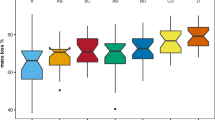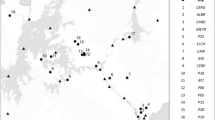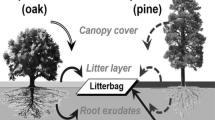Abstract
Studies on pine ecosystem functioning were carried out in different climates along a W–E transect extending more than 1500 km across Central-Eastern Europe (Germany-Poland-Belarus). Decomposition of litter in litter bags, measured at 13 locations simultaneously during 1995 and 1996 was correlated with components of climate: long-term annual temperature (TANN), temperature amplitude (TAMP) defined as the difference between temperatures of the warmest and coldest months, annual precipitation (PANN) and precipitation amplitude (PAMP). The content of eight metallic elements (Mn, Fe, Zn, Cu, Ni, Cr, Pb, Cd) was determined in litters from the same stands and correlations with decomposition rates were estimated. In those 13 pine stands influenced by gradually changing thermoclimate, the role of chemical factors was evaluated. It is suggested that similar interactions between decomposition, thermoclimate and metallic elements can occur in the case of climate change. In the warmer year, 1995, statistically significant correlations between decomposition rate and metal content or climatic factors were more frequent. Among the four fractions of litter analysed, needle litter responds most to the presence of climate and metals as regards its decomposition. Results from the calculation of partial correlations excluding the influence of various climatic factors suggest that a synergistic interaction might exist between two groups of factors driving decomposition processes, i.e. climate (in this case TANN, TAMP and CONT) and litter chemistry.
Similar content being viewed by others
References
Berg, B. and Ekbohm, G. L.: 1991, ‘Litter mass-loss rates and decomposition patterns in some needle and leaf litter types. Long term decomposition in a Scots pine forest, VII’, Can. J. Bot. 69, 1449–1456.
Bolin, B., Degens, E. T., Duvigneaud, P., and Kempe, S.: 1979, ‘The global biogeochemical carbon cycle’, in Bolin, B., Degens, E. T., Kempe, S., Ketner, P. (eds.), The Global Carbon Cycle, SCOPE, Vol. 13, pp. 1–53.
Breymeyer, A. I.: 1991, ‘Comparative analysis of organic matter transformations in coniferous forests in Europe’, in Nakagoshi, N., Golley, F. B. (eds.), Coniferous Forest Ecology, from an International Perspective, SPB Academic Publishing, pp. 161–178.
Breymeyer, A.: 1997, ‘Transect studies of pine forests along parallel 52°N 12–32°E and along a pollution gradient in Central Europe: General assumptions. climatic conditions and pollution deposition’, Environmental Pollution 98(3), 335–345.
Breymeyer, A., Degórski, M., and Reed, D.: 1997, ‘Decomposition of pine-litter organic matter and chemical properties of upper soil layers: transect studies’, Environmental Pollution 98(3), 361–367.
Breymeyer, A.: 1998, ‘Transect studies of pine forests along parallel 52°N, 12–32°E and along a pollution gradient in Central Europe: General assumptions, climatic conditions and pollution deposition’, Dokumentacja Geograficzna 13, Inst. of Geography, PAS, Warsaw, 11–30.
Breymeyer, A., Mroz, G., Reed, D., and Degórski, M.: 1998, ‘Warunkowanie tempa dekompozycji ściótki sosnowej przez zmieniaj acy sie klimat i sktad chemiczny substratu. Badania na transektach. (The conditioning of rates of pine-litter decomposition by changing climate and substrate chemical composition. Transect studies)’, Dokumentacja Geograficzna 13, Inst. of Geography, PAS, Warsaw, 187–205.
Cannell, M. G. R., Dewer, R. C., and Thornley, J. H. M.: 1992, ‘Carbon flux and storage in European forests’, in Teller, A., Mathy, P., and Jeffers, J. N. R. (eds.), Responses of Forest Ecosystems to Environmental Changes, Elsevier Applied Science, London and New York, pp. 256–271.
Chomicz, K.: 1977, Materiaty do poznania agroklimatu Polski (Agroclimate of Poland), PWN, 307p.
Degórski, M.: 1998, ‘A morpholithological characterization of pine forest and mixed pine forest habitats along a climatic transect (52°N, 12°-32°E) and a “Silesian” transect’, Dokumentacja Geograficzna 13, Institute of Geography PAS, Warsaw, 31–40.
Ellenberg, H., Weber, H. E., Dull, R., Wirth, V., Werner, W., and Paulissen, D.: 1991, Zeigerwerte von Pflanzen in Mitteleuropa, Scripta Geobotanica, 18, Göttingen.
Emanuel, W. R., Killough, G. G., and Olson, J. S.: 1981, ‘Modeling the circulation of carbon in the world’s terrestrial ecosystems’, in Bolin, B. (ed.) Carbon Cycle Modelling, SCOPE, Vol. 16, pp. 335–354.
Europe’s Environment: The Second Assessment: 1998, EEA, Office for Official Publications of the European Communities, Elsevier Science LTD, Oxford, p. 293.
Forest Condition in Europe: 1999, Executive Report. UN/ECE and EC, Geneva and Brussels: 31p + Annex.
Galiński, W.: 1993, ’The confrontation of the annual carbon balances of Polish forest ecosystems for the years 1989, 1990 and 1991’, in V-th Symposium on the Protection of Forest Ecosystems, Forest ecosystems versus climate change, Białowieża, pp. 241–248.
Grodzinski, W., Weiner, J., and Maycock, P. F. (eds.): 1984, Forest Ecosystems in Industrial Regions, Springer Verlag.
Kauppi, P. E., Mielikäinen, K., and Kuusela, K.: 1992, Biomass and carbon budget of European forests, 1971 to 1990, Science, Reprint Series 3 April 1992, Vol. 256, pp. 70–74.
Knight, D. H.: 1991, ‘Pine forests: A comparative overview of ecosystem structure and function’, in Nakagoshi, N. and Golley, F. B. (eds.) Coniferous Forest Ecology, from an International Perspective, SPB Academic Publishing, pp. 121–136.
Kowalski, M.: 1993, ‘Changes in forest species composition as related to climate change during the last two centuries’, in V-th Symposium on the Protection of Forest Ecosystems, Forest ecosystems versus climate change, Białowieża, pp. 13–22.
Kreutzer, K.: 1992, ‘Forest response to a changing environment – Central and Northern European aspects’, in Teller, A., Mathy, P. and Jeffers, J. N. R. (eds.), Responses of Forest Ecosystems to Environmental Changes, Elsevier Applied Science, London and New York, pp. 279–297.
Lindacher, R. (ed.): 1995, Phanart Datenbank der Gefässpflanzen Mitteleuropas, Erklarung der Kennzahlen, Aufbau und Inhalt (Phanart, Databese of Centraleuropean Vascular Plants, Explanation of codes, Structure and Contents), Verõffentlichungen Geobotanischen Institut der ETH Stiftung Rübel, 125, Zürich.
Mälkönen, E., Helmisaari, H.-S., Lindgren, M., and Raitio, H.: 2000, ‘Forest condition in Finland – concluding remarks’, in Mälkönen, E. (ed.) Forest Condition in a Changing Environment, Kluwer Academic Publishers, Dordrecht/Boston/London, pp. 361–367.
Malzahn, E. and Rachwald, H.: 1995, ‘Variability of forest environment chemistry in the Bialowieza forest area with a low pollution level’, in Paschalis, P., Rykowski, K., and Zajczkowski, S. (eds.) Protection of Forest Ecosystems Biodiversity of Białowieża Primeval Forest. GEF 05/21685 POL, Warsaw, pp. 19–32.
Matuszkiewicz, W. and Matuszkiewicz, J. M.: 1973, A phytosociological review of Poland’s forest communities. Part 2. Pine Forests, Phytocoenosis 2. 4.
Matuszkiewicz, J. M.: 1987, Geobotaniczne zróżnicowanie lasów iglastych Polski (The geobotanical differentiation of Poland’s coniferous forests), in Breymeyer, A. (ed.) Coniferous Forests in Poland. Dokumentacja Geograficzna 3, Inst. of Geography, PAS, Warsaw, pp. 46–72.
Mooney, H. A.: 1991, ‘Biological response to climate change: An agenda for research’, Ecol. Appl. 1(2), 112–117.
Nieminen, T., Derome, J., Helmisaari, H.-S., and Janhunen, S.: 2000, ‘Response of tree stands to heavy metal loading’, in Mälkönen, E. (ed.) Forest Condition in a Changing Environment, Kluwer Academic Publishers, Dordrecht/Boston/London, pp. 278–283.
O’Neil, R. W. and De Angelis, B.: 1981, ‘Comparative productivity and biomass relations of a forest ecosystem’, in Reichle, D. E. (ed.), Dynamic Properties of Forest Ecosystems, Cambridge University Press, pp. 411–449.
Prentice, I. C., Cramer, W., Harrison, S. P., Leemens, R., Monserud, R. A., and Solomon, A. M.: 1992, ‘A global biome model based on plant physiology and dominance, soil properties and climate’, J. Biogeogr. 19, 117–134.
Rice, W. R.: 1989, ‘Analyzing tables of statistical tests’, Evolution 43(1), 223–225.
Roo-Zieli-ska, E. and Solon, J.: 1997, ‘Effect of geographical location on species composition. vegetation structure, diversity and phytoindicative characteristics in pine forests’, Environ. Pollut. 98(3), 347–360.
Roo-Zielińska, E. and Solon, J.: 1998, A geobotanical characteristic and analysis of the range of forest communities at study sites along climatic (52°N, 12°–32°E) and “Silesian” transects. Dokumentacja Geograficzna 13, Inst. of Geography, PAS, Warsaw, pp. 79–98.
Solon, J. and Roo-Zieli-ska, E.: 1998, Differentiation of herb–layer structure in pine and mixed pine forests along a climatic (52°N, 12°–32°E) and a “Silesian” transect. Dokumentacja Geograficzna 13, Inst. of Geography, PAS, Warsaw, pp. 99–112.
Forest damage in Poland evaluated by state monitoring in: 1998, State Inspectorate for Environment Protection, Library of Environment Monitoring, Warsaw 1999.
Walker, B. H.: 1996, ‘Conclusion. Predicting a future terrestrial biosphere: Challenges to GCTE science’, in Walker, B. and Steffen, W. (eds.), Global Change and Terrestrial Ecosystems, Cambridge University Press, Cambridge, pp. 595–607.
Wawrzoniak, J.: 1999, ‘Chemical composition of pine and spruce needles in the forest monitoring stands (1998)’, in Forest Damage in Poland Evaluated by State Monitoring in 1998, Inspekcja Ochrony Srodowiska. Warszawa, pp. 56–61.
Wawrzoniak, J. and Malachowska, J.: 1999, ‘Final conclusions’, in Forest Damage in Poland Evaluated by State Monitoring in 1998, Inspekcja Ochrony Srodowiska. Warszawa, pp. 80–83.
Woodward, F. I., Smith, T. M., and Emanuel, W. R.: 1995, ‘A global primary productivity and phytogeography model’, Glob. Biogeochem. Cycles 9, 471–490.
Vogt, K. A., Gordon, J. C., Wargo, J. P., Vogt, D. J., Asbjornsen, H., Palmiotto, P. A., Clark, H. J., O’Hara, J. L., Keaton, W. S., Patel, Weynand, T., and Witten, E.: 1997, Ecosystems: Balancing Science with Management, Vol. IX, Springer, New York, p. 470.
Author information
Authors and Affiliations
Rights and permissions
About this article
Cite this article
Breymeyer, A. Are Chemical And Climatic Drivers Synergistic?. Climatic Change 71, 221–248 (2005). https://doi.org/10.1007/s10584-005-5921-4
Issue Date:
DOI: https://doi.org/10.1007/s10584-005-5921-4




